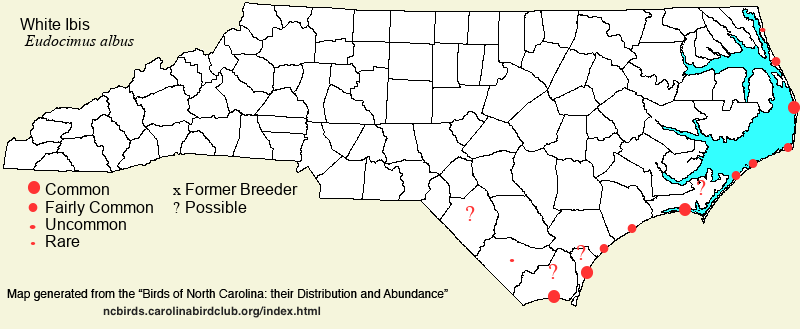 |  |
|
White Ibis - Eudocimus albus THRESKIORNITHIDAE Members: | Search Common: Search Scientific: |
|
|
|||||||
| General Comments | One of the most common of our coastal wading birds, the White Ibis has increased dramatically in the state over the last 50-60 years. Despite the fact that over 10,000 pairs nest in the state annually, over 95% of them nested until about 2009 only at one site -- Battery Island near Southport. (The birds mysteriously moved off the island, and many or most of these are now breeding on one or two islands farther north in the lower Cape Fear River.) The species does nest in scattered other coastal colonies north to Currituck, and at one or two slightly inland sites. Battery Island birds were known to make daily round-trips to the Waccamaw River (over 30 miles one way); thus, the birds nesting along the lower Cape Fear spread out over a wide area near the southern coast. Despite the fact that the species is near the northern edge of its range in the mid-Atlantic states, birds are quite hardy in winter, and fairly large numbers remain to overwinter. As with most other waders, the species does wander inland across much of the state after the breeding season. The White Ibis is often seen foraging in shallow fresh waters of open swamps, shallow waters, and mudflats, but it also forages in brackish and salt water and on mudflats. And, White Ibises will also feed on lawns and occasionally in plowed fields. Inland, most birds are seen feeding on mudflats at lakes/reservoirs where shorelines are exposed. | ||||||
| Breeding Status | Breeder | ||||||
| NC BRC List | Definitive | ||||||
| State Status | W | ||||||
| U.S. Status | |||||||
| State Rank | S3B,S3N | ||||||
| Global Rank | G5 | ||||||
| Coastal Plain | Year-round breeding resident along the coast, with migratory movements. Common to locally very common, more numerous along the southern coast; numbers reduced only slightly in winter, such that it is only fairly common and somewhat local in winter on the Outer Banks. Breeds on small coastal islands, with other wading birds. In Tidewater, mostly rare to uncommon in the warmer months, and can be rare in winter. Farther inland, formerly nested at Warwick Mill Bay (Robeson), and might still do so, and nests at Lay's Lake (Columbus). At other locales, mainly a rare to uncommon post-breeding visitor, from mid-Jun to late Aug; however, seems to be remaining all winter well inland in Duplin, Columbus, and other nearby counties. In fact, 253 were counted coming to a roost near Magnolia (Duplin) on 29 Jan 2025, and about 140 were seen near Chadbourn (Columbus) on 16 Jan 2025. Large numbers were seen well inland in Tyrrell and Martin in spring 2025; are birds nesting in these inland counties? Out-of-season inland records, both at Woodlake (Moore): one on 7 Feb 2000, and one on 13 Mar 2008. Peak counts: 1,462, counted in flight to a roost at Browns/Harker Island (Carteret), 31 May 2022. Peak well inland: 387 in Martin on 24 May 2025; 197 in Tyrrell on 15 Mar 2025. | ||||||
| Piedmont | Post-breeding visitor, essentially only in summer and fall. Rare to uncommon along the eastern edge of the region, but generally rare over most of the Piedmont; mainly late Jun to mid-Sep. A flock of 12 in flight in Alamance on 16 Apr 2015 was most unusual for the spring season; even more notable in spring was 28 in flight at Lake Twitty (Union) on 28 May 2020, following Tropical Storm Bertha. Peak counts: 140, Jordan Lake, 14 Aug 1980; 114, Jordan Lake, 19 Jul 2024. | ||||||
| Mountains | Post-breeding visitor. Rare at low elevations in the southern mountains; very rare in the central and northern mountains and above 2,500 feet; mid-Jun to late Sep. Two out-of-season records: 1, Pisgah Forest (Transylvania), 6 Dec 1995; and 1, in flight near Weaverville (Buncombe), 7 Feb 2022. Peak count: 7, Brevard (Transylvania), 21-22 Aug 2022. | ||||||
| Finding Tips |
This species is difficult to miss along the coast, at mudflats, shallow waters of ponds and inlets, and on occasions even in grassy areas such as lawns and plowed fields. Inland, your best bet is at a large lake, where there are extensive mudflats, during Jul or Aug. **** | ||||||
| Attribution | LeGrand[2025-07-27], LeGrand[2025-05-08], LeGrand[2024-11-04] | ||||||
| NC Map Map depicts all counties with a report (transient or resident) for the species. | Click on county for list of all known species. |
| NC Breeding Season Map Map depicts assumed breeding season abundance for the species. |  |